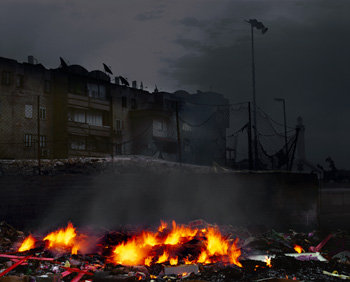Dor Guez / Nevet Yitzhak
dal 4/11/2009 al 4/2/2009
Segnalato da
4/11/2009
Dor Guez / Nevet Yitzhak
Petach Tikva Museum of Art, Petach Tikva
Georgiopolis / A Great Joy Tonight

Dor Guez
Georgiopolis
Curator Drorit Gur Arie
"Georgiopolis," Dor Guez's one-person exhibition, proposes, for the first time, scrutiny of the Christian-Arab minority in Israel, a reference group which has not heretofore been granted profound perusal as a differentiated ethnic group in the local cultural field. "Georgiopolis" (City of St. George, the Christian name of the city of Lod in the 12th century) unfolds the story of a single Christian-Arab family extending over three generations, sketching cultural, religious, ethnic, and historical junctions.
The title of the exhibition is intended to remind viewers of the intricate place of the Christian-Arab-Israeli-Palestinian community in-between the two majority groups in Israel: the Jews, for whom the city is Lod; and the Palestinians for whom it is Lydd. Georgiopolis, which has grown nearly invisible, re-surfaces in-between, acquiring a pivotal presence as yet another figure in Guez's works. The exhibition introduces the voice of the Christian Arabs as an ethnic minority in Israel and a religious-ethnic minority among the Muslim Arabs, challenging the validity of prevalent conventions in the local public discourse as they encounter the private, the personal, and the human.
Spanning photography, video, and sound works, the exhibition is centered on three generations in the Lod-based Monayer family, whose story is entwined with the history of the city, which was occupied in 1948 by the Hagana and the majority of its citizens were expelled. The chronicles of the family, which stayed in the city and rehabilitated itself there, are outlined through the personal experiences of the grandfather, Jacob, his four sons—Salim, Samih, Sami, and Silver, and the young granddaughters—Samira and Jenifer, creating a moving, personal, inter-generational mosaic of identities of an intricate multi-lingual and multi-cultural existence.
Guez's project transpires in the realm of praxis and discourse in-between history, anthropology, and art, while employing a cinematic practice underlain by a testimonial-documentary dimension. Guez, who is absent-present in his works, uses documentary raw materials presenting the collection of evidence brought before him. His work reports, from the very first sight, its being evasive, possibly deceptive, devoid of a master narrative, and in any event—one which refuses an unequivocal definition of its identity, much like his interviewees who present to us complex world views, replete with conflicts and nuances.
The exhibition challenged the prevalent order of identities in Israel, and the attempt to label identities under narrow, limited categories such as "Israeli," "Christian-Arab," "Palestinian," etc. It offers a new perspective on the dilemma of identity and the definition of the different identities in the Israeli sphere.
While addressing highly charged, partly political, historical issues, Guez presents viewers with these questions through human stories, in a poetical, stratified manner which exposes multiple layers, personal perspectives, and diverse experiences of his protagonists. The power of Guez's work lies in its ability to confront any viewer—regardless of ethnic and/or cultural origin—with their own position concerning notions such as "nationality," "identity," "ethnicity."
----
Nevet Yitzhak
A Great Joy Tonight
Curator Drorit Gur Arie
The Israel Broadcasting Authority (IBA) Arabic Orchestra was established in 1948 and operated until 1993 as part of Arabic Kol Israel (Radio D). Most of the musicians were Jewish immigrants from Iraq and Egypt who arrived in Israel in the early 1950s. Initially, the orchestra played musical fragments which were interspersed in quiz shows. Later on its repertoire included original music and music from the Arab world. In 1957, upon the arrival of musician Zuzu Musa from Egypt, the Orchestra was reorganized in the form familiar to the public from its (later) performances on national television. The Orchestra was one of the key institutions of Arabic music in Israel, and acquired listeners from the entire region. Unfortunately, its documentation and the historical sources concerning its activity are lacking.
The title of Nevet Yitzhak’s work is drawn from Inbal Perlson’s book by the same name. Perlson studied, for the first time, the political-historical contexts and circumstances which led these musicians, decades after their immigration to Israel, to cling to this cultural world and continue to live a language and music they had brought with them from their countries of origin.
Yitzhak’s work employs original IBA archival material presenting the orchestra performing in the program "Music and Song." Yitzhak deconstructs and reconstructs these materials.
The new visual-musical work loses some of the authenticity of the original music, yet reintroduces the tradition and the past. By lingering on a moment in the past, Yitzhak furnishes the orchestra with a new platform.
Image: Dor Guez, Lydd Ruins (Market Square), 2009. C-print, 120x150 cm
For guided group tours and seminars, please contact Ariela, Marketing Department: 03-9286304
Sun.-Thurs. 8:00 a.m.-4:30 p.m. Fax: 03-9223026 arielak@ptikva.org.il
Opening: 5 November 2009, 8 p.m.
Petach Tikva Museum of Art
30 Arlozorov st., P.O. Box 1, Petach-Tikva 49100
Opening hours
mon, wed, fri, sat 10:00-14:00
tues., thus. 16:00-20:00



